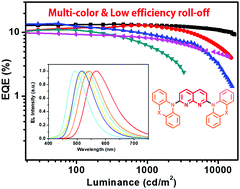Naphthyridine-based thermally activated delayed fluorescence emitters for multi-color organic light-emitting diodes with low efficiency roll-off†
Abstract
Three new 1,8-naphthyridine-based thermally activated delayed fluorescence (TADF) emitters, 2,7-di(9,9-dimethylacridin-10(9H)-yl)-1,8-naphthyridine (DMAC-ND), 2,7-di(10H-phenothiazin-10-yl)-1,8-naphthyridine (PTZ-ND) and 2,7-di(10H-phenoxazin-10-yl)-1,8-naphthyridine (PXZ-ND), were designed and synthesized. They possessed twisted structures and small ΔEST, which could make them show excellent TADF and AIDF properties. Consequently, multi-color organic light-emitting diodes (OLED) based on emitters DMAC-ND, PTZ-ND and PXZ-ND were fabricated, which could achieve a maximum external quantum efficiency (EQE) of 14.1, 13.4 and 13.0%, respectively. Moreover, all devices exhibited relatively low turn-on voltages and low efficiency roll-off ranging from 4.5% to 20% at the luminance of 1000 cd m−2 probably owing to the microsecond-scale delayed photoluminescence (PL) and AIDF properties of the emitters. Notably, a DMAC-ND-based non-doped device reached the luminance of 20 000 cd m−2 easily at the voltage of 6.5 V, and exhibited very low efficiency roll-off of 4.5% at the luminance of 1000 cd m−2 and 33.6% at the luminance of 10 000 cd m−2.



 Please wait while we load your content...
Please wait while we load your content...